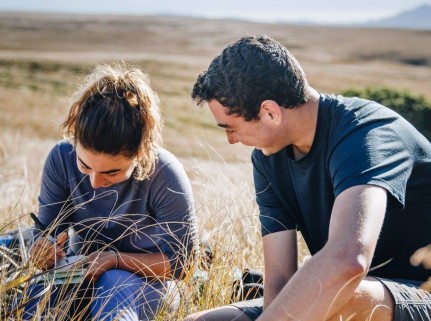The mellow vibe of Hoi An was a nice change of pace from the chaotic streets of Hanoi; sidewalks were not flooded with pushy pedestrians and motorbikes weren't always coming at you from every direction. We loved getting to explore the city by foot beneath the lanterns that hang over the old quarter. We got a good taste for the charming city from shopping in the old quarter, navigating the night market, and hanging out at the beach just adjacent to the city. Every morning, we packed up our sarongs, water bottles, and sunscreen in our backpacks and hopped on a bike to see where the day would take us.
Biking in Vietnam was not a simple stroll on the sidewalk. We shared the road with street vendors, cabs, tourists taking selfies in the middle of the road, and weaving motorcyclists, often carrying enough people to make up an entire family. The variety of road obstacles became even larger the further we ventured outside the city; one day, we were on a ride through a nearby village when a herd of cattle decided that they were going to use the road. About 20 cows walked single-filed through the narrow road we were pulled over on, completely unfazed by our presence. Six weeks before that would have floored us, but we were as equally unfazed as the meandering cattle.
One day in Hoi An, we shared a beautiful day at the beach taking in the views and embracing an afternoon without an itinerary. While some people laid on the sand in pure relaxation mode listening to music and reading their books, others picked up a game of soccer. It started off low-key, but grew more and more intense as other people from down the beach joined in, not ending until the rising tide and setting sun forced it to.
Known for having clothing stores that will make personalized clothing for you, Hoi An was a great place for shopping. Many of the girls brought in pictures of dresses we liked, got measured, and by the next day we had a fun new dress perfectly tailored for us. There are also many leather good stores that will make shoes and sell very authentic looking knock-offs. We learned not to touch anything unless we were seriously considering buying it, though, because the second you do, the sales clerk will not take no for an answer.
In an attempt to escape from the vendors and overflowing clothes of Hoi An for a bit, many of us visited the My Son sanctuary one morning. My Son is a series of Hindu temple ruins constructed over a thousand years from the fourth to the fourteenth century. It was used for religious ceremonies and was a burial place for kings of the Champa dynasty. We found it fascinating look at ruins that are anywhere from 600-1600 years old.
Another day, we stretched our artistic muscles (or lack thereof) on a visit to the Lifestart Foundation. The Lifestart Foundation helps disadvantaged Vietnamese families become self-sufficient through various programs and initiatives. We supported this foundation by taking a crafts lesson at their center, with half of us making paper lanterns and the other half painting on rice paper with small brushes. It was satisfying to know that we were supporting a good organization in the process of enjoying Vietnam's charms.
From the land of tailors and beaches, we traveled to the land of 7 million scooters and a dense history, Saigon, or Ho Chi Minh City. Saigon feels similar to Hanoi, with a constant flow of people on motorbikes and a mixing of locals and tourists through it, but is even bigger and has this massive scale to it. Now that may intimidate that average traveler, but from caves, elephants, jungles, and much more, we have definitely taken more risks than the average traveler. And so, we went up and down Saigon, to restaurants, shops, and markets, looking for the best deal or the best meal. We had a blast trying to navigate the city in two busy days.
During our stay in Saigon, we went to the Cu Chi tunnels as well as the War Remnants museum. The Cu Chi tunnels were an amazingly intricate network built by villagers and the Viet Cong during the war where they could hide from the biological warfare and use it as a point to attack American militia. We entered the tunnels, going down a mind-numbingly small opening and crawling through it for about 100 meters. We were definitely in our stretch zone as even the most brave of us had feelings of claustrophobia down there. It was unbelievable to us that people could live in those tiny bunkers for years, whereas we could barely make it five minutes.
At the War Remnants museum, we saw pictures, artifacts, and quotes from soldiers and locals who experienced the war. With the majority of us being American, it was very eye-opening for us to understand exactly what we as a country had done to innocent Vietnamese locals during that period of time, beyond the superficial knowledge we have learned in class. It was a strange guilt that we felt as Americans going through the museum, but, during a discussion we had afterward, we were able to translate that into feelings of empathy for those who had suffered during the war.
In our efforts to be ethical travelers, we welcomed these experiences: we adventured through the narrow streets of Hoi An by bike, we braved the hot sun to see ancient temples that are mostly in ruin, and we faced a more difficult part of our own nation's history.
To be an ethical traveler, you have to take some risks, and so we have (while having a whole lot of fun in the process).



Leave a Comment
Your email address will not be published. Required fields are marked *